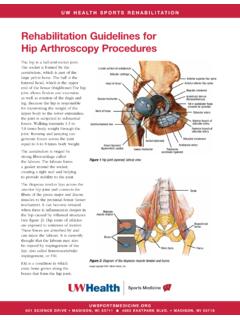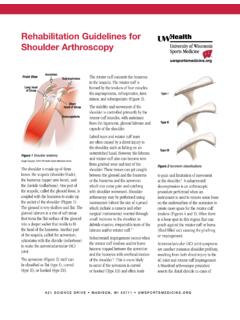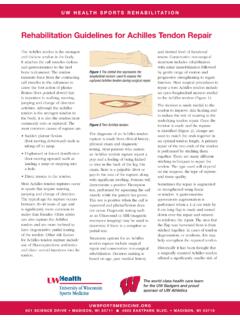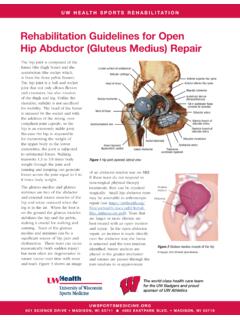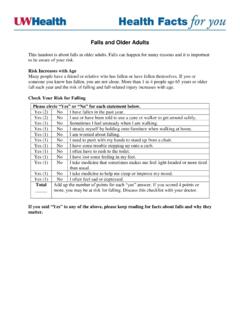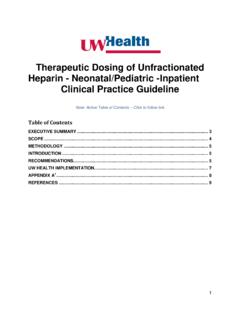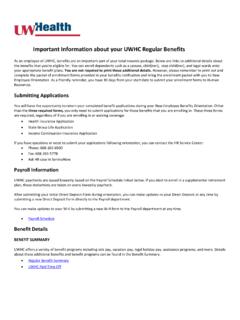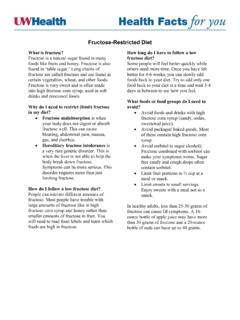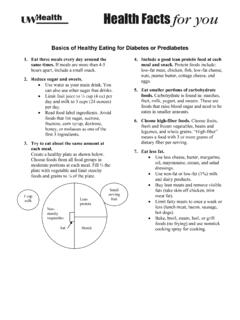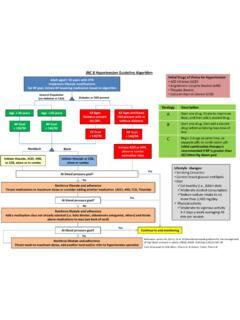Transcription of Prophylaxis Guidelines - UW Health
1 Venous Thromboembolism Prophylaxis . Adult Inpatient/Ambulatory . Clinical Practice Guideline Table of Contents EXECUTIVE SUMMARY .. 1. SCOPE .. 6. METHODOLOGY .. 6. DEFINITIONS (OPTIONAL): .. 7. INTRODUCTION .. 7. RECOMMENDATIONS .. 7. BENEFITS/HARMS OF IMPLEMENTATION ..13. IMPLEMENTATION PLAN AND TOOLS ..ERROR! BOOKMARK NOT DEFINED. REFERENCES ..13. APPENDIX A ..13. Note: Active Table of Contents Click to follow link CPG Contact for Changes: CPG Contact for Content: Name: Philip Trapskin, PharmD, BCPS Name: Anne Rose, PharmD. Phone Number: 263-1328 Phone Number: 263-9738. Email Address: Email Address: University of Wisconsin Hospitals and Clinics Page 1.
2 Guideline Authors: Jennifer Lai, PharmD, BCPS. Coordinating Team Members: Anne Rose, PharmD. Review Individuals/Bodies: Inpatient Anticoagulation Committee Pharmacy and Therapeutics Committee Committee Approvals/Dates: Inpatient Anticoagulation Committee: Pharmacy and Therapeutics Committee: Release Date: Initial: April 2010. Update: October 2014. Next Review Date: October 2016. University of Wisconsin Hospitals and Clinics Page 2. Executive Summary Guideline Overview This guideline is intended to provide recommendations for identifying individual venous thromboembolism (VTE) risk and bleeding risks for adult hospitalized patients and to provide recommendations for preventative therapies based on VTE and bleeding risk.
3 Target Population The recommendations within this guideline for the prevention of VTE would apply to any adult patient with the intent to remain hospitalized for greater than 24 hours. The recommendations for pharmacologic strategies used to prevent VTE would apply to adult patients receiving either unfractionated heparin (UFH), low molecular weight heparin (LMWH) or fondaparinux. Key Practice Recommendations 1. Prevention of VTE in Hospitalized Patients2,5. All hospitalized patients should be evaluated for both bleeding and VTE risk within 24. hours of admission, upon transferring level of care, and periodically during the hospital stay (Class I, Level B).
4 2. Evaluating VTE risk in medical patients The Modified Padua Risk Assessment Model should be used to assess VTE risk in medical ,4 (Class I, Level B). Table 1: Modified Padua Risk Assessment Model2,4,6,7. Risk Factor Points Critically Ill 4. Inflammatory Bowel Disease 4. Active Cancer* 3. Previous VTE 3. Reduced Mobility** 3. Thrombophilic Condition** 3. Recent (< 1month) Trauma/Surgery 2. Age 70 years 1. Heart or Respiratory Failure 1. Acute Myocardial Infarction or Ischemic Stroke 1. Acute Infection or Rheumatologic Disorder 1. BMI 30 1. Ongoing Hormonal Treatment 1. Active cancer is defined as local or distant metastases and with chemotherapy or radiation in the previous 6 months Reduced mobility is defined as anticipated bed rest with bathroom privileges for at least 3 days Thrombophilic condition is defined as defects of antithrombin, protein C or S, factor V.
5 Leiden, G20210A prothrombin mutation, or antiphospholipid syndrome University of Wisconsin Hospitals and Clinics Page 3. Table 2: Modified Padua Risk Assessment Score2,4 (Class I, Level B). Points Risk Recommendation <4 Low VTE Risk VTE Prophylaxis not needed >4 High VTE Risk and Low Bleed Risk Pharmacologic Prophylaxis High VTE Risk and High Bleed Risk Mechanical Prophylaxis Table 3: VTE Prophylaxis Regimens for High VTE Risk Medical Patients 2,8-14. Patient Population VTE Prophylaxis Regimens Medical patients Enoxaparin 40 mg SQ every 24 hours (Class I, Level B). OR. Heparin 5000 units SQ every 8 to 12 hours (Class I, Level B). Renal impairment Enoxaparin 30 mg SQ every 24 hours (Class IIa, Level B).
6 (CrCl < 30 mL/min)* OR. Heparin 5000 units SQ every 8 to 12 hours (Class I, Level B). *Not on renal replacement therapy Extreme obesity patients Enoxaparin 40 mg SQ every 12 hours (Class IIa, Level B). 2. (BMI > 40 kg/M ). Low body weight patients Enoxaparin 30 mg SQ every 24 hours (Class IIb, Level C). (weight < 50 kg) OR. Heparin 5000 units SQ every 8 to 12 hours (Class I, Level B). 3. Evaluating VTE risk in surgical patients The Caprini Risk Assessment Model should be used to assess VTE risk in general and abdominal-pelvic surgery ,15 (Class I, Level B). Each risk factor is associated with a point value and the total risk score is cumulative.
7 Table 4: Caprini Risk Assessment 1 Point 2 Points 3 Points 5 Points Age 41-60 Age 61-74 Age 75 Acute spinal cord injury (< 1 mo). Acute MI (<1 mo) Central venous Established Elective lower extremity access thrombophilia arthroplasty BMI > 25 Immobile > 72 hrs HIT Hip, pelvis, or leg fracture (< 1 mo). CHF exacerbation Leg plaster cast or Hx of VTE Stroke (< 1 mo). (<1 mo) brace Hx of inflammatory Malignancy Family hx VTE. bowel disease (1 degree relative). Procedure with local Surgery- arthroscopic anesthesia Swollen legs or Surgery > 45 mins Varicose veins Sepsis (< 1 mo). Serious lung dx ex. Pneumonia (<1 mo). 1 point (For Women Only).
8 Oral contraceptives or HRT. Pregnancy or postpartum (< 1 month). Hx of unexplained stillborn infant, spontaneous abortion ( 3), premature birth with toxemia or growth restricted infant University of Wisconsin Hospitals and Clinics Page 4. Established thrombophilia is defined as factor V Leiden, G20210A prothrombin mutation, antiphospholipid syndrome, lupus anticoagulant, elevated serum homocysteine, and heparin induced thrombocytopenia3,17(Class I, Level B). Table 5: Caprini Risk Assessment Score3,15(Class I, Level B). Points Risk Recommendation 0 Very Low VTE Risk Early and frequent ambulation 1-2 Low VTE Risk Mechanical Prophylaxis 3-4 Moderate VTE Risk and Low Bleed Risk Pharmacologic Prophylaxis >5 High VTE Risk and Low Bleed Risk Mechanical AND Pharmacologic Prophylaxis >2 High Bleed Risk Mechanical Prophylaxis Table 6: VTE Prophylaxis Regimens for High VTE Risk General Surgical Patients3,8-10,13,14,16,17.
9 Surgical Patients Enoxaparin 40 mg SQ every 24 hours (Class I, Level B). OR. Heparin 5000 units SQ every 8 to 12 hours (Class I, Level B). Renal impairment Enoxaparin 30 mg SQ every 24 hours (Class IIa, Level B). (CrCl < 30 mL/min)* OR. Heparin 5000 units SQ every 8 to 12 hours (Class I, Level B). *Not on renal replacement therapy Bariatric Surgery Enoxaparin 40 mg SQ every 12 hours (Class IIa, Level B). Major Trauma Enoxaparin 30 mg SQ every 12 hours (Class IIa, Level B). Abdominal/Pelvic Enoxaparin 40 mg SQ every 24 hours (Class I, Level B). Surgery for Cancer Companion Documents AppendixB Padua VTE Risk Assessment Model AppendixC Caprini VTE Risk Assessment Model Appendix D Orthopedic VTE Risk Assessment Patient Resources: HFFY 6915 Heparin (Unfractionated and Low Molecular Weight).
10 HFFY 7522 Deep Vein Thrombosis and Pulmonary Embolism Prevention and Treatment University of Wisconsin Hospitals and Clinics Page 5. Scope Adult inpatients receiving unfractionated heparin (UFH), low molecular weight heparin (LMWH),or fondaparinux therapy for the prevention of venous thromboembolism (VTE). Intended Users: Physicians Advanced Practice Providers Pharmacists Registered Nurses CPG objective(s): This clinical practice guideline is intended to provide recommendations for identifying patients who are at risk for developing VTE, to provide recommended therapy options to reduce the risk of VTE during hospitalization and to provide recommended therapy options for extended VTE.
